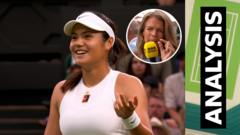Do Players Have a Reason to Distrust Hawk-Eye at Wimbledon?

## A Deep Dive into the Controversy Surrounding Wimbledon’s Line-Calling System
Wimbledon, one of the most prestigious tennis tournaments globally, has always been a stage for remarkable athletic prowess and, at times, intense controversy. The recent match between Emma Raducanu and Aryna Sabalenka showcased not only the exceptional skills of these players but also raised critical questions about the technology behind line-calling at this iconic event. In this article, we will explore the intricacies of Wimbledon’s line-calling system, delve into the specific incident that sparked debate, and analyze the implications for players and the sport as a whole.
### Understanding Wimbledon’s Line-Calling Technology
Wimbledon has long been at the forefront of incorporating technology into tennis to enhance the accuracy of officiating. The tournament employs a combination of traditional line judges and advanced technological systems to ensure fair play. Here’s a closer look at the technology involved:
#### Hawk-Eye Technology
Hawk-Eye is the primary line-calling system used at Wimbledon. This technology employs multiple high-speed cameras positioned around the court to capture the trajectory of the ball. The system calculates the ball's landing spot with high precision, usually within a margin of error of just a few millimeters.
- **How it Works:**
- Cameras track the ball’s flight.
- The data is processed in real-time.
- Players can challenge calls using Hawk-Eye, leading to an instant replay.
#### Line Judges
While technology plays a significant role, human line judges are still an integral part of the officiating team. These officials provide a layer of oversight, particularly in close-call situations. However, the reliance on human judgment can sometimes lead to inconsistencies, as seen in Raducanu's match.
### The Controversial Call: What Happened?
During Raducanu’s match against Sabalenka, a pivotal moment occurred that left players and fans questioning the reliability of the line-calling system. An important point in the match was impacted by what appeared to be an incorrect call, leading to frustration from Raducanu and her supporters.
#### Key Details of the Incident
- **The Moment:** A crucial serve from Raducanu was called out, despite many believing the ball landed in. The call had significant implications for the match's momentum.
- **Player Reactions:** Following the call, Raducanu expressed her disbelief, stating that the technology seemed to have failed in delivering an accurate judgment.
### The Implications of the Incident
The fallout from this controversial call extends beyond just one match. It raises broader questions about the effectiveness of technology in tennis and its impact on players' confidence and the game's integrity.
#### Potential Effects on Players
1. **Psychological Impact:**
- Players may experience doubt regarding the accuracy of calls, which can affect their performance.
- The pressure to perform in high-stakes matches could be influenced by the fear of technological errors.
2. **Trust in Technology:**
- Continuous controversies may lead players to question the reliability of the Hawk-Eye system.
- If players lose faith in technology, it could lead to more disputes on the court.
3. **Impact on Spectators:**
- Fans and viewers are likely to become more critical of officiating decisions, leading to calls for improvements and changes in the system.
- Spectators may lose interest if they feel that matches are marred by officiating errors.
### The Debate: Technology vs. Human Judgment
As technology continues to evolve, so does the debate surrounding its role in sports. The incident during Raducanu’s match has reignited discussions about the balance between technology and human officiating in tennis.
#### Arguments for Enhanced Technology
- **Increased Accuracy:** Proponents argue that technology like Hawk-Eye significantly reduces human error, providing more accurate calls.
- **Transparency:** With instant replay and clear visual evidence, fans can engage more deeply with the sport and understand the decisions made.
#### Arguments for Maintaining Human Officiating
- **Human Element:** Critics argue that human judges bring a level of intuition and experience that technology cannot replicate.
- **Technology Limitations:** There are instances where technology may fail, leading to errors that affect the outcome of matches.
### Moving Forward: Possible Solutions
In light of the ongoing debates about line-calling accuracy and technology's role in officiating, several potential solutions could be explored:
1. **Enhancement of Technology:**
- Continuous upgrades to the Hawk-Eye system to improve its accuracy and reliability.
- Implementation of additional camera angles and sensors to capture more data.
2. **Training for Line Judges:**
- Enhanced training programs for line judges to ensure they are well-equipped to make accurate calls, particularly in challenging situations.
- Regular assessments and evaluations of line judges to maintain high standards.
3. **Review Mechanisms:**
- Instituting a review system where controversial calls can be re-evaluated after the match, leading to potential adjustments in rules or technology use.
- Open dialogue between players, officials, and tournament organizers to address concerns and suggestions.
### Conclusion
The recent controversy surrounding the line-calling system at Wimbledon highlights the challenges and complexities of officiating in tennis. While technology has undoubtedly improved the accuracy of calls, it is essential to find a balance between human judgment and technological assistance. The debate will likely continue as players, fans, and officials navigate the evolving landscape of the sport.
As we reflect on these developments, it's crucial to consider how they may shape the future of tennis. Will advancements in technology lead to a more fair and engaging sport, or will the human element always remain an indispensable part of the game?
### FAQs
#### What is Hawk-Eye technology in tennis?
Hawk-Eye technology uses multiple high-speed cameras to track the ball's trajectory and determine its landing spot with high precision. It is used to make line calls and can be challenged by players during matches.
#### How do players challenge line calls?
Players can challenge line calls by signaling to the umpire, who then uses the Hawk-Eye system to verify the call. If the challenge is successful, the original call may be overturned.
#### Why do some players question the accuracy of line-calling systems?
Players may question the accuracy of line-calling systems due to past incidents where technology has failed, leading to incorrect calls that have significant implications for match outcomes.
The debate surrounding technology in tennis is ongoing, and it will be fascinating to see how these discussions evolve in the coming years. What do you think about the balance of technology and human judgment in sports?
#Tennis #Wimbledon #SportsTechnology
Published: 2025-07-05 11:27:14 | Category: sport



